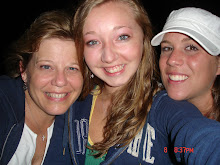I have entered the 21st century--I now have created not only a blog but a web site. Okay, I was required to do this for my Educational Technology class, but it turned out to be a lot more fun than I anticipated. The web site is all about my Educational Technology class and the projects I worked on--Photoshop, PowerPoint, Visual Essay, etc. You can follow a link to view my visual essay, The Making of a Cheerleader, if you're feeling like a quiz, follow the link to my PowerPoint and take a 10 question non-linear interactive study quiz on Romeo & Juliet, or listen to my Podcast of a sonnet by Edna St. Vincent Millay. If anyone wonders where I've been and what I've been doing for the month of July 2007, this web site should answer that question. Follow the link below to visit the site. I hope you enjoy it!
http://www.students.fairfield.edu/s_ebroderick/
Thursday, July 26, 2007
Monday, July 23, 2007
The Computer Delusion
This excellent article by Todd Oppenheimer may have been written in 1997, however, the topics it explores are just as relevant today. The article talks about the Clinton administration's efforts to get computers into the classroom, but makes it clear that the training of teachers and the technical support for the computers wasn't considered. Oppenheimer looks at some case studies to determine that when teacher training and educational goals mesh with the right computers and software, computers can be a boon to the classroom. But when the computers are old, the software is dated and the teachers aren't trained, the computers are no better than turning on a TV. Oppenheimer draws a clear line from the days when some educators were excited about the uses of radios and filmstrips in the classroom to how excited some educators are about computers. The technology is brand new and shiny and everyone is sure it's the next best thing. But is it? This was the most intelligent article I've read about computers and the classroom because it looks at both sides of the issue. The final quote sums up my view of technology and education far better than I can, "We need to teach the whys and the ways of the world. Tools come and tools go. Teaching our children tools limits their knowledge to these tools and hence limits their futures."
Big6: Information Problem Solving
The Big6 is an information skills model to teach students information problem solving. This was an academic paper written about a particular case study. As with many academic papers, this was poorly written and not always easy to follow, but the basic idea of information problem solving is excellent. The world is not wrapped up in a neat little package. Life is messy and daily life presents us with many problems and challenges, big and small that we need to solve and overcome. Information problem-solving is a skill that everyone needs and can be applied to both academics as well as every-day life and careers. I prefer teaching kids how to use information and their own brains to solve a problem.
Friday, July 20, 2007
Non-Linear PowerPoint in the Classroom
When it comes to applying all this new technology to the classroom, I am at a bit of a loss due to my lack of classroom experience. What I envision might be a lot of fun for the kids as well as educational might not actually work. I do sometimes think we get caught up in how cool and fun all these programs are and don't carefully question exactly how helpful they are to the students. I like the idea of using non-linear PPT for study guides, quizzes and games, but I must defer to my more experienced classmates when it comes to how they can be appropriately used in the classroom
Thursday, July 19, 2007
Is there a digital divide?
There is a digital divide and will be until all students have equal access not only to the computer hardware and software, but also to trained and skilled instructors. There may be equal access to education in this country, but there isn't equal access to learning.
Tuesday, July 17, 2007
Reflections on Ed Tech Class
I have to borrow from Lindsay and say I have also experienced a love/hate relationship with this class. I find the technology fascinating and it has been fun to learn new and interesting programs, but the sheer volume of work we are attempting to master and complete in such a short time frame has been frustrating. My favorite thing so far has been the blog. I love working on my blog!! I've sent the web address to all my friends and family and I've received some great feedback. I was worried about the web site project, but today, with some help from Jenn and John I feel like I have a handle on it. I believe learning to work with the
Monday, July 16, 2007
Value-Added Technology
I was taught the old-fashioned way--with books. Much as it pains me to admit it (and dates me) there were no computers in the classroom when I first attended school. I didn't work on a computer until I had my first post-graduate job. Lack of technology didn't hurt me, I went on to a successful career, but I have experienced in my career the way advancements in technology can make a j0b easier, better and in some instances, even more difficult. The same would apply to the classroom. Technological advancements have opened up a new world on learning. The concept of UDL transforms the access students have to learning and allows educators to reach a broad spectrum of learners. So what is the value added to the classroom by technology? New ways to teach students, greater access to information and a variety of programs to help teachers and students utilize that information. While there are downsides to technology: privacy issues, Internet predators, time wasting, expense etc., I do think the pros outweigh the cons. One big problem we have not addressed in class is those students being left behind because their schools and their families can not afford to provide them with the access to the technology that other students enjoy. That is elephant in the room that needs to be acknowledged in any discussion of technology and teaching.
Creative Commons & Open Educational Resources
I was intrigued by the idea of Creative Commons so although I enjoyed many of the other sites, I believe this one would be most useful for me getting started as an educator. Having done the research on copyright law, using a site like this for both my own work and for student work is ideal. There is no worry about copyright infringement and there is so much available all on one site. No matter what the project your students are working on: digital essay, Power Point, Blogs, Websites, papers, scrapbooks, collages, etc. there is something available for students to work with. This Wiki space also talked about Open Educational Records. As someone new to the educational field, this type of resource is invaluable and could have saved me a few sleepless nights last semester as I struggled to develop my first thematic plan. Both of these sites are going to be bookmarked for future use. I don't forsee any problems with these two sites, only possibilities.
Sunday, July 15, 2007
Universal Design For Learning
Using Inspiration, I created this diagram of the concept of Universal Design For Learning. The basic concept begins with Digital Media and its flexible nature. The idea of UDL is to manipulate information so that it is accessible to all learners and supports their diversity.
The Miracle of Photoshop

I was a fashion editor for over 20 years. When I began, digital photography wasn't an option. We used old-fashioned film and Polaroid for shoots. More than once we had to do a photo over because the photographer forgot to load the camera. One time the entire shoot had to be recreated because the film was damaged. Because of my work with professional photographers, I was very aware of the advances of digital photography from the beginning and experienced the wizardry a talented photographer can perform with Photoshop. I now have even more respect for the technology since I had the chance to play around with Photoshop in class. I took two photos from a 2005 Memorial Day parade that Shannon's cheer squad took part in along with some soldiers recently back from Iraq. Since Memorial Day honors all of our soldiers I decided to add in some veterans of the Civil War.
Saturday, July 14, 2007
Inquiry-Based Learning & Historical Thinking
Part of the challenge of being a middle-aged graduate education student is that I was taught in a typical American classroom style for my entire educational career. The teacher was the fountain of all knowledge who stood in front of the classroom and dispensed wisdom and knowledge to the students. I learned what I was told and properly regurgitated it back to the teacher in the form of quizzes, tests, papers and projects. The concepts of Inquiry-Based Learning and Historical Thinking were probably in their infancy (if even that) when I graduated from my first masters program at Fairfield in 1985. In 2007, I am experiencing an entirely new classroom setting, and from what I hear from my fellow students who are already educators, the classroom and how teachers and students interact has changed dramatically. Teachers are no longer all-knowing and value is placed on the students contributing to the classroom discussion and creation and transfer of knowledge. Memorization and mastery of facts, figures and dates is no longer the ultimate goal for most teachers. Their new goal is to provide the student with the tools he/she needs to research and find their own answers, generate their own understanding, and view the world not through the narrow view of specific bits of information but to interrelate that information to create new knowledge. This new type of classroom has been an eye-opening experience for me and there are times I wish I could go back to high school and college and do it all again with this new generation of educators. I hope to be one of them.
Copyright Law & the Classroom
Copyright law is a fluid and mercurial area of the law. As I researched the use of copyrighted materials in the classroom, I kept coming back to the image of a child with his nose pressed up against the window of the candy store. So much sugary sweetness to be experienced, but the threat of parental repercussions outweigh the momentary pleasure. The plethora of new technology and the unlimited access to images and information that the Internet provides are a teacher's candy store. But breaking dense and often contradictory copyright laws gives the informed educator pause. A teacher can not claim ignorance of the law. He/she must be informed and follow the school's guidelines on the use of copyrighted material and should set a responsible standard for the use of copyrighted material in the classroom. A good rule of thumb is to apply the four-factor test of fair use to any use of copyrighted material and when in doubt, check with school administration. Click on this link for a pdf chart on Fair Use.
http://www.techlearning.com/techlearning/pdf/events/techforum/tx05/TeacherCopyright_chart.pdf
http://www.techlearning.com/techlearning/pdf/events/techforum/tx05/TeacherCopyright_chart.pdf
Wednesday, July 11, 2007
Cheerleaders: Real Athletes?
The question everyone asks: Is cheerleading a sport? Yes, it is. Cheerleaders train as hard if not harder than any other ahtletes and they compete nationally against other squads. Our favorite saying: Athletes lift weights; Cheerleaders lift athletes.
Digital Imagery & Teaching Standards
As the deck to my blog details, words can paint pictures and evoke emotions. But as the old saying goes, a picture is worth a thousand words. As a writer, I tend to be partial to words, but you can't deny the emotional impact of a strong visual image. With the new technology available, students can apply visual images to their projects to work hand-in-hand with their written work. The teaching standard for English demands that students be able to express their comprehension of the content and to draw conclusions, nowhere does it say this has to be done in written form. They could absolutely do this using digital imagery to create a photo collage, a digital essay, a scrapbook, etc.
Tableau Vivant

The things we do for our education! Our group had to recreate the story of the Grasshopper and the Ant, or in this case, the Ants. As we eat our food happily, the lazy grasshopper is dying of hunger. I truly enjoyed this activity and would absolutely try to use it in a classroom setting. It was a great icebreaker and allowed me to get to know some of my classmates. I like group activities where everyone has to participate, there is no room for someone to step back and not take part. Plus, as someone who hopes to teach English and History, this type of activity is a twofer. You can have the kids research TV for a history lesson and then switching to English, they can come up with their own stories to recreate. Lots of fun, creativity, technology and learning all in one activity.
Monday, July 9, 2007
Teaching Standards
I chose the English/Language Arts Standard for grades 9-12. I am not yet a teacher, however, I am deep enough into this program now to recognize the vast differences between how I was taught as a high school student and how teachers are being trained to teach now. Personally, I think the new methods are better. Rather than a teacher standing in front of the room and telling the students what to think, I applaud the idea of helping the students learn to think, process and analzye material for themselves. I suport the idea of group dialogue, of teaching through the use of various media and for allowing students to have some choice in the material they read and the methods in which they demonstrate their knowledge and understanding of the text.
Using MP3 players for homework
Thinking back to the learning styles quiz, the use of MP3 players in the classroom or for homework makes sense for auditory learners. However, it could have disatrous results for a tactile or visual learner. I like the idea of this technology being offered as an option to students, but would hesitate to make it a mandatory part of the classroom. I am split 50/50 in my learning styles. I would definitely consider using an MP3 player for certain areas of coursework, but for extremely complicated material, I need to have it right in front of me on paper.
Subscribe to:
Posts (Atom)











